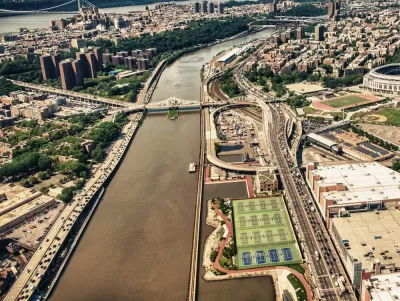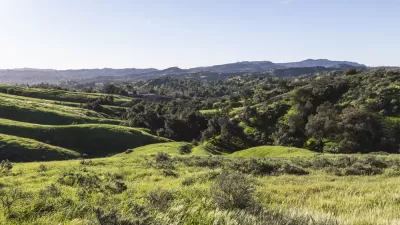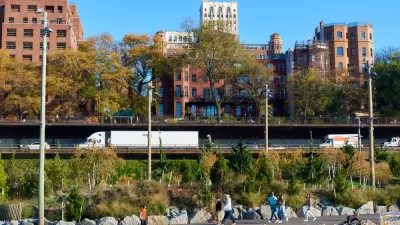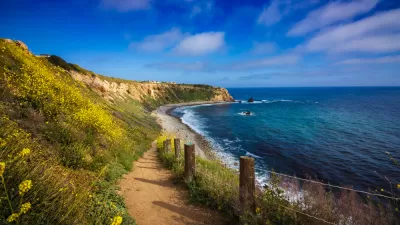Deborah Marton, executive director of the New York Restoration Project, connects parks and open space to improved public safety.

The cool shade of a tree-covered garden is the only respite from summer heat in many urban areas. In New York City, it's also an important tool for reducing crime rates. Increasing green space can drive down crime by more than 200 felonies per year in a single urban neighborhood. That's one finding from a study that found transforming New York City derelict lots into vibrant green space significantly improved public safety.
It's not just grass and trees. People who embrace parks—who garden and have picnics and play dominos—drive down crime by creating the "social capital" that builds community. It's people like 65-year-old Jose Reyes, a retired mechanic who can almost always be found in El Cataño Garden in East Harlem, tending his plants, sweeping the paths in the summer and shoveling snow in the winter.
The study, commissioned by New York Restoration Project, examined the impact of turning abandoned lots into small, beautiful parks in low-income neighborhoods. They compared crime rates in communities that benefited from green investment with demographically similar areas that were starved for it. The results were dramatic.
Neighborhoods with higher investment in parks and gardens saw an average of 213 fewer felonies each year. That’s at least 2-3 fewer serious crimes every week.
This study is just the latest in a growing body of research that shows the crime-fighting potential of vibrant green spaces. In Philadelphia for example, researchers found that rehabilitating blighted lots decreased gun violence and made people feel safer. In Youngstown, Ohio, researchers found that crime rates dropped when public lots were maintained. And in Baltimore, crime appeared to decrease when private lawns were well-cared for.
There are many reasons why flourishing green spaces improve public safety. Removing signs of disorder and demonstrating care sends a message to residents that their community is valued and supports local groups to drive strength from within. Improved lighting is a well-known crime deterrent, but perhaps most important, well-designed and maintained parks function as community hubs, what sociologist Eric Klinenberg describes as "social infrastructure." These are "the physical places and organizations that shape the way we interact," where neighbors can gather and get to know each other, developing social capital.
In times of crisis, the strength of a community's social infrastructure can be a matter of life and death.
In his eye-opening book, Heat Wave, Klinenberg analyzed starkly different mortality rates between demographically similar communities during the 1995 Chicago heat wave. What made the difference? People living in neighborhoods with better social infrastructure had more active social networks which made them more likely to check on isolated neighbors and help each other.
Skeptics may question whether population-dense cities can really find the land needed for new parks. But here in New York City, despite tremendous residential development, there remain hundreds of vacant land parcels that, put together, would be bigger than two Central Parks.
This growing body of research showing that green space decreases crime should serve as an urgent call to action to police departments, public health officials, and public safety leaders across the country. To reduce crime we need fewer vacant lots and more investment in our green spaces. It's a proven strategy that empowers neighborhoods and improves quality of life for residents. And the non-profit sector is an effective partner. New York Restoration Project partnered with the city of New York on its successful campaign to plant one million trees in 2015. The first-of-its-kind effort brought a canvas of new green space to underserved neighborhoods that needed it most, and we continue to support hundreds of community partners through programming, education, and coalition building.
If East Harlem’s green renaissance can protect its residents from 213 felonies per year, what could be achieved in cities across the country? The clock is ticking. Gardeners like Jose Reyes are standing by to become the stewards of these parks and the leaders of these crime-fighting green communities.
Deborah Marton is the executive director of the New York Restoration Project.

Planetizen Federal Action Tracker
A weekly monitor of how Trump’s orders and actions are impacting planners and planning in America.

Congressman Proposes Bill to Rename DC Metro “Trump Train”
The Make Autorail Great Again Act would withhold federal funding to the system until the Washington Metropolitan Area Transit Authority (WMATA), rebrands as the Washington Metropolitan Authority for Greater Access (WMAGA).

The Simple Legislative Tool Transforming Vacant Downtowns
In California, Michigan and Georgia, an easy win is bringing dollars — and delight — back to city centers.

The States Losing Rural Delivery Rooms at an Alarming Pace
In some states, as few as 9% of rural hospitals still deliver babies. As a result, rising pre-term births, no adequate pre-term care and "harrowing" close calls are a growing reality.

The Small South Asian Republic Going all in on EVs
Thanks to one simple policy change less than five years ago, 65% of new cars in this Himalayan country are now electric.

DC Backpedals on Bike Lane Protection, Swaps Barriers for Paint
Citing aesthetic concerns, the city is removing the concrete barriers and flexposts that once separated Arizona Avenue cyclists from motor vehicles.
Urban Design for Planners 1: Software Tools
This six-course series explores essential urban design concepts using open source software and equips planners with the tools they need to participate fully in the urban design process.
Planning for Universal Design
Learn the tools for implementing Universal Design in planning regulations.
Smith Gee Studio
City of Charlotte
City of Camden Redevelopment Agency
City of Astoria
Transportation Research & Education Center (TREC) at Portland State University
US High Speed Rail Association
City of Camden Redevelopment Agency
Municipality of Princeton (NJ)





























